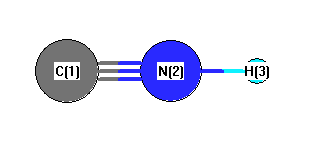Vibrational levels (cm-1) 
| Mode Number |
Symmetry |
Frequency |
Intensity |
Comment |
Description |
| Fundamental(cm-1) |
Harmonic(cm-1) |
Reference |
(km mol-1) |
unc. |
Reference |
| 1 |
Σ |
3653 |
|
Gurvich |
|
|
|
|
|
| 2 |
Σ |
2029 |
|
Gurvich |
|
|
|
|
|
| 3 |
Π |
477 |
|
Gurvich |
|
|
|
|
|
vibrational zero-point energy: 3317.9 cm
-1 (from fundamental vibrations)
Calculated vibrational frequencies for
HNC (hydrogen isocyanide).
Geometric Data

Point Group C∞v
Internal coordinates
distances (r) in Å, angles (a) in degrees, dihedrals (d) in degrees
| Description |
Value |
unc. |
Connectivity |
Reference |
Comment |
| Atom 1 |
Atom 2 |
Atom 3 |
Atom 4 |
| rCN |
1.173 |
|
1 |
2 |
|
|
Gurvich |
|
| rNH |
0.986 |
|
2 |
3 |
|
|
Gurvich |
|
| aHNC |
180 |
|
1 |
2 |
3 |
|
Gurvich |
|
Cartesians
| Atom |
x (Å) |
y (Å) |
z (Å) |
| C1 |
0.0000 |
0.0000 |
-0.7405 |
| N2 |
0.0000 |
0.0000 |
0.4321 |
| H3 |
0.0000 |
0.0000 |
1.4183 |
Atom - Atom Distances 
Distances in Å
| |
C1 |
N2 |
H3 |
| C1 |
|
1.1726 | 2.1588 |
| N2 |
1.1726 |
|
0.9862 |
| H3 |
2.1588 | 0.9862 |
|
Calculated geometries
for HNC (hydrogen isocyanide).
Experimental Bond Angles (degrees) from cartesians 
| atom1 |
atom2 |
atom3 |
angle |
| C1 |
N2 |
H3 |
180.000 |
Bond descriptions
Examples: C-C single bond, C=C, double bond, C#C triple bond, C:C aromatic bond
| Bond Type |
Count |
| C#N |
1 |
| H-N |
1 |
Connectivity
| Atom 1 |
Atom 2 |
| C1 |
N2 |
| N2 |
H3 |
Dipole, Quadrupole and Polarizability
Electric dipole moment 
| State |
Config |
State description |
Conf description |
Exp. min. |
Dipole (Debye) |
Reference |
comment |
Point Group |
Components |
| x |
y |
z |
total |
dipole |
quadrupole |
| 1 |
1 |
1Σ |
C∞v |
True |
|
|
|
3.050 |
NISTtriatomic |
MW +-0.1D μ0 |
C∞v |
1 |
1 |
Experimental dipole measurement abbreviations: MW microwave; DT Dielectric with Temperature variation; DR Indirect (usually an upper limit); MB Molecular beam
Calculated electric dipole moments for
HNC (hydrogen isocyanide).
Electric quadrupole moment 
| State |
Config |
State description |
Conf description |
Exp. min. |
Quadrupole (D Å) |
Reference |
comment |
Point Group |
Components |
| xx |
yy |
zz |
dipole |
quadrupole |
| 1 |
1 |
1Σ |
C∞v |
True |
|
|
|
|
|
C∞v |
1 |
1 |
Calculated electric quadrupole moments for
HNC (hydrogen isocyanide).











